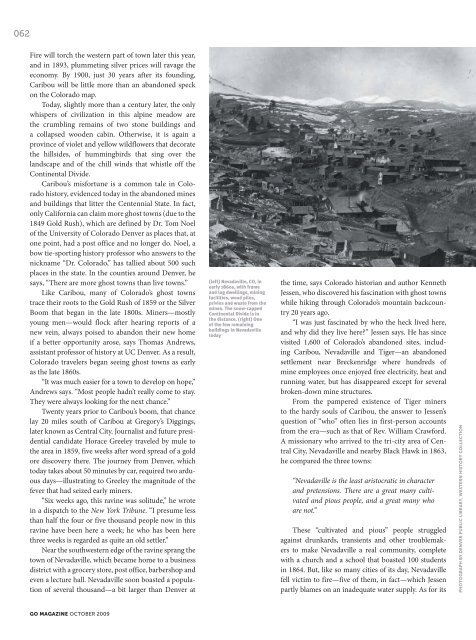You also want an ePaper? Increase the reach of your titles
YUMPU automatically turns print PDFs into web optimized ePapers that Google loves.
062<br />
Fire will torch the western part of town later this year,<br />
and in 1893, plummeting silver prices will ravage the<br />
economy. By 1900, just 30 years after its founding,<br />
Caribou will be little more than an abandoned speck<br />
on the Colorado map.<br />
Today, slightly more than a century later, the only<br />
whispers of civilization in this alpine meadow are<br />
the crumbling remains of two stone buildings and<br />
a collapsed wooden cabin. Otherwise, it is again a<br />
province of violet and yellow wildflowers that decorate<br />
the hillsides, of hummingbirds that sing over the<br />
landscape and of the chill winds that whistle off the<br />
Continental Divide.<br />
Caribou’s misfortune is a common tale in Colorado<br />
history, evidenced today in the abandoned mines<br />
and buildings that litter the Centennial State. In fact,<br />
only California can claim more ghost towns (due to the<br />
1849 Gold Rush), which are defined by Dr. Tom Noel<br />
of the University of Colorado Denver as places that, at<br />
one point, had a post office and no longer do. Noel, a<br />
bow tie-sporting history professor who answers to the<br />
nickname “Dr. Colorado,” has tallied about 500 such<br />
places in the state. In the counties around Denver, he<br />
says, “There are more ghost towns than live towns.”<br />
Like Caribou, many of Colorado’s ghost towns<br />
trace their roots to the Gold Rush of 1859 or the Silver<br />
Boom that began in the late 1800s. Miners—mostly<br />
young men—would flock after hearing reports of a<br />
new vein, always poised to abandon their new home<br />
if a better opportunity arose, says Thomas Andrews,<br />
assistant professor of history at UC Denver. As a result,<br />
Colorado travelers began seeing ghost towns as early<br />
as the late 1860s.<br />
“It was much easier for a town to develop on hope,”<br />
Andrews says. “Most people hadn’t really come to stay.<br />
They were always looking for the next chance.”<br />
Twenty years prior to Caribou’s boom, that chance<br />
lay 20 miles south of Caribou at Gregory’s Diggings,<br />
later known as Central City. Journalist and future presidential<br />
candidate Horace Greeley traveled by mule to<br />
the area in 1859, five weeks after word spread of a gold<br />
ore discovery there. The journey from Denver, which<br />
today takes about 50 minutes by car, required two arduous<br />
days—illustrating to Greeley the magnitude of the<br />
fever that had seized early miners.<br />
“Six weeks ago, this ravine was solitude,” he wrote<br />
in a dispatch to the New York Tribune. “I presume less<br />
than half the four or five thousand people now in this<br />
ravine have been here a week; he who has been here<br />
three weeks is regarded as quite an old settler.”<br />
Near the southwestern edge of the ravine sprang the<br />
town of Nevadaville, which became home to a business<br />
district with a grocery store, post office, barbershop and<br />
even a lecture hall. Nevadaville soon boasted a population<br />
of several thousand—a bit larger than Denver at<br />
GO MAGAZINE OCTOBER <strong>2009</strong><br />
(left) Nevadaville, CO, in<br />
early 1860s, with frame<br />
and log dwellings, mining<br />
facilities, wood piles,<br />
privies and waste from the<br />
mines. The snow-capped<br />
Continental Divide is in<br />
the distance. (right) One<br />
of the few remaining<br />
buildings in Nevadaville<br />
today<br />
the time, says Colorado historian and author Kenneth<br />
Jessen, who discovered his fascination with ghost towns<br />
while hiking through Colorado’s mountain backcountry<br />
20 years ago.<br />
“I was just fascinated by who the heck lived here,<br />
and why did they live here?” Jessen says. He has since<br />
visited 1,600 of Colorado’s abandoned sites, including<br />
Caribou, Nevadaville and Tiger—an abandoned<br />
settlement near Breckenridge where hundreds of<br />
mine employees once enjoyed free electricity, heat and<br />
running water, but has disappeared except for several<br />
broken-down mine structures.<br />
From the pampered existence of Tiger miners<br />
to the hardy souls of Caribou, the answer to Jessen’s<br />
question of “who” often lies in first-person accounts<br />
from the era—such as that of Rev. William Crawford.<br />
A missionary who arrived to the tri-city area of Central<br />
City, Nevadaville and nearby Black Hawk in 1863,<br />
he compared the three towns:<br />
“Nevadaville is the least aristocratic in character<br />
and pretensions. There are a great many cultivated<br />
and pious people, and a great many who<br />
are not.”<br />
These “cultivated and pious” people struggled<br />
against drunkards, transients and other troublemakers<br />
to make Nevadaville a real community, complete<br />
with a church and a school that boasted 100 students<br />
in 1864. But, like so many cities of its day, Nevadaville<br />
fell victim to fire—five of them, in fact—which Jessen<br />
partly blames on an inadequate water supply. As for its<br />
PHOTOGRAPH BY DENVER PUBLIC LIBRARY, WESTERN HISTORY COLLECTION
















